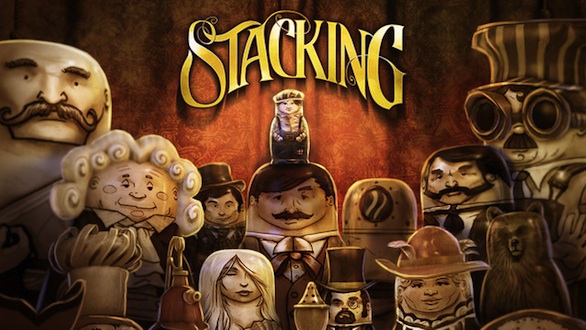

Over the past two decades, video games have ascended from being a subculture to becoming one of the biggest entertainment industries of our generation. Many of us enjoy AAA titles, such as Call of Duty, Super Mario Bros. or Grand Theft Auto. In the past few years, however, the industry has witnessed an explosion of small developers producing indie games, exploring innovative new game concepts and offering these hand-crafted experiments at low prices. I’ll be reviewing a recently released indie title, Stacking, to offer you a small taste of what you might be missing and what’s waiting to be explored.
Stacking
In a world populated by Russian stacking dolls, you control the littlest doll out there, Charlie Blackmore, who has to save his kidnapped family by hopping into bigger dolls and using their unique abilities. Stacking is a third-person adventure puzzle game developed by Double Fine Productions, the makers of the renowned Psychonauts.
Look & Feel:
Set in Russia around the time of the Industrial Revolution, Stacking revels in its old-time setting, sending the player through detailed, atmospheric environments such as a grand train station, a flying zeppelin and a tank engine train. Each level is surprisingly lively, thanks to the large amount of other stacking dolls going about their lives; you’ll find families of dolls of different sizes, old men reading news papers and young children running around. The entire game presents itself like a silent movie, including dialogue cards during cutscenes and parlor music in the background of every level, and there’s a subtle film grain over everything you see to reinforce this style. Though you won’t be blown away by the realism or crispness of the graphics, the hand-drawn style instills each doll with personality, and the detail packed into the environments helps immerse you into the strange world in a way realistic graphics never could.
Gameplay:
The principle gameplay mechanic in Stacking is Charlie’s ability to take over bigger dolls and use their abilities, which range from the mundane (like blowing bubbles) to the oddly specific (like pouring gruel) to the useful (like shoving other dolls out of your path). In each of the four large levels, you must solve several puzzles using a combination of abilities, which can only be done by scouring the level for dolls with the skills you need.
The puzzles themselves, however, are quite easy to solve. So easy, in fact, that the game encourages you to try to solve them in different ways to unlock trophies as rewards. While it’s fun to try approaching the same challenge from a new perspective, the solutions are never quite as satisfying as they could be since they’re individually not terribly hard to figure out; it is likely that you will only need one or two abilities in tandem to solve the puzzle. Most of the difficulty, especially towards the end of the game, comes not from devising clever solutions but locating the exact doll you need, which can get tiring in the expansive environments. Honestly though, the numerous abilities are fun outside of puzzle solving, and discovering new dolls and abilities to try out is often its own reward.
Story:
While the atmosphere of Stacking is rich, the story is fairly bare-bones, though it integrates well with the setting. The game begins with a slightly dark tone, as Charlie’s father goes missing and the rest of the family is forced to work in coal mines to repay his massive debts. Charlie soon discovers that the government is keeping the family as slaves and sets off to save them. It’s a dark beginning for a light-hearted game, but the tone shifts as soon as gameplay starts and the urge to explore takes over. You’re reminded at the beginning of each level why Charlie does what he does, but the story is mostly background fluff until the ending.
Replay:
The aforementioned multiple puzzle solutions already greatly increase the lifespan of the game. With at least three puzzles per level, and anywhere from three to six solutions per puzzle, plenty of challenges remain even if you choose to rush through the story. If the allure of 100 percent completion weren’t enough, the game rewards you with a Trophy Room, where the doll used for each solution is immortalized as a statue for you to admire later. In addition, for each character in the game, there are mini-challenges called Hi-Jinks, where performing x amount of actions decorates the doll and adds a little extra cosmetic flair to the game. There are also matching sets of dolls that can be found, which are also collected in your Trophy Room. Finally, there are achievements for discovering both dolls and solutions. Overall, the addictive hoarder/“gotta catch em all” rewards add great replay value and allows you to appreciate the fine art direction in the game long after you’ve finished the story.
Value:
With an MSRP of $15, Stacking costs far less than an AAA title, especially for such a recent release. Compared to other indie offerings, it’s one of the costlier games out there, but it packs a lot of good gameplay into the package, bursts with personality and features a remarkable amount of polish to justify the price.
I chose this game as my first review for The Student because to me, it illustrates some of the best qualities that indie games have to offer. The ratings below are based on a scale from 0 to 2, where 0 means this game may not be for you if you find this aspect important, 1 means you should enjoy this aspect of the game and 2 means an outstanding aspect of the game.
Stacking can be purchased on Steam, Xbox Live Arcade and Playstation Network for $15.